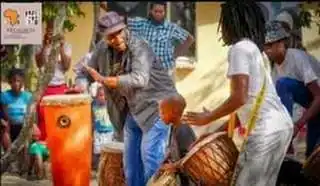Whispers of the Isles: A Story of the Islands of Los
African reflection
African culture, communities of West Africa
STRANGE 1
LOS island celebration

Off the shimmering coast of Guinea, where the Atlantic stretches wide and deep, lies a cluster of emerald isles known as the *Îles de Los*.
To the unknowing eye, they seem like any tropical paradise—swaying palms, sun-kissed beaches, and warm ocean breezes.
But beneath the surface, these islands whisper tales of ancient peoples, colonial ambitions, and hard-fought freedom.
Rain forest in Guinea

Walking in Guinea forest

Chimpanzee baby with keeper Guinea

The name “Los” is thought to have come from the Portuguese word *Ilhas dos Ídolos*—“Islands of the Idols.”
When Portuguese sailors first arrived in the 15th century, they found the local Baga people practicing their spiritual traditions, with carved figures and rituals that the newcomers didn’t understand.
Over time, the name shortened, as so many colonial names did, becoming simply "Los."
Guinea forest road

There are several islands in the group, the most notable being Kassa, Tamara, and Roume. Each island has its own rhythm, its own memory of the past.
DEVIL'S ISLAND
**Roume** was once a notorious center in the Atlantic slave trade. In the 18th century, it became a base for European traders who struck grim deals with coastal African rulers.
Drums of Ivory Coast

Slaves captured inland were brought to the island before being shipped across the ocean.
You can still find the crumbling ruins of colonial buildings and slave pens—silent witnesses to a painful history.
Village in Guinea forest

**Tamara Island** played a different, but equally significant role.
In the 19th century, it became a kind of administrative outpost for the French colonial empire.
A lighthouse still stands tall there, guiding ships through the waters and reminding travelers of the time when France, in its imperial might, ruled much of West Africa.
Later, during the fight for independence, Tamara served briefly as a political prison—Guinea's future leaders held there under suspicion and fear.
Breakdown in rainforest

**Kassa**, larger and livelier, was always the heart of the islands.
Fishermen still cast their nets as their ancestors did, and markets fill with the scent of smoked fish and tropical fruit.
Kassa, like all of Guinea, has changed, yet it holds fast to its cultural roots.
The Shadowed Walls of Kassa
Though today Kassa Island hums with life—fishermen hauling in nets, children playing on the shore, and the pulse of modern Guinea—it once bore a more haunting presence: a French colonial prison of grim reputation.
During the height of French West Africa’s colonial administration, Kassa was chosen not just for its strategic location, but for its isolation.
The very thing that makes the island a paradise today—its separation from the mainland and natural beauty—made it ideal for exile and punishment.
The prison on Kassa was more than just a place to house petty criminals.
It became a place of political repression, used to silence dissenting voices during the turbulent years of French rule.
Guinea Westafrica

Local leaders, anti-colonial agitators, and those deemed a threat to the colonial administration were often shipped to the island without trial.
Once there, they were cut off from the world, forced into hard labor, and left to wither in brutal conditions.
The facility earned a sinister reputation not only for its harsh discipline but also for the stories that seeped out—accounts of disease, malnutrition, and the psychological toll of isolation.
Escape was nearly impossible. The strong Atlantic currents surrounding Kassa served as natural barriers, and guards ensured few ever had the chance to try.
In the early 20th century, as nationalist movements began to gain momentum across French West Africa, Kassa’s prison was increasingly used as a tool of political suppression.
Guinean activists who challenged the colonial status quo could find themselves disappeared to its cells.
Many of those held there went on to play key roles in Guinea’s independence movement after their release, carrying with them the memory—and trauma—of their imprisonment.
Village in rainforest

After Guinea declared independence in 1958 under Ahmed Sékou Touré, the prison was eventually abandoned.
Nature began to reclaim what colonial hands had built.
Today, the ruins of the prison still stand on Kassa—overgrown, eroded, and eerily silent.
Ruins of Kassa French colonial prison

Few tourists visit the site, and locals often speak of it with a mixture of pride and pain—a symbol of resistance, survival, and the cost of freedom.
Today, the Îles de Los are quiet but never forgotten.
Locals travel there for peace, tourists come for their beauty, and historians arrive chasing ghosts of the past.
The islands are a mosaic of natural splendor and deep memory—where history meets the horizon, and the sea keeps its secrets.
THE DEVILS ISLAND
PAST AND RECENT EVENTS
FINAL JOURNEY : George K. - may you rest in eternal peace my friend
In honour of George I will show one of the interviews given by him, where he narrates a story when he arrived in Africa 1956 during the Suez Canal conflict.
His legacy will live on.
George narrating his experiences whilst on a flight over Suez in 1956 :

